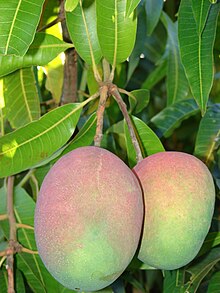Mangifera is a genus of flowering plants in the cashew family, Anacardiaceae. It contains about 69 species, with the best-known being the common mango (Mangifera indica). The center of diversity of the genus is in the Malesian ecoregion of Southeast Asia, particularly in Sumatra, Borneo, and the Malay Peninsula.[2][3] They are generally canopy trees in lowland rainforests, reaching a height of 30–40 m (98–131 ft).[4]
| Mangifera | |
|---|---|
 | |
| M. indica fruits | |
| Scientific classification | |
| Kingdom: | Plantae |
| Clade: | Tracheophytes |
| Clade: | Angiosperms |
| Clade: | Eudicots |
| Clade: | Rosids |
| Order: | Sapindales |
| Family: | Anacardiaceae |
| Subfamily: | Anacardioideae |
| Genus: | Mangifera L. |
| Synonyms[1] | |
Mangas Adans.Phanrangia Tardieu | |
Uses
Mangifera species are widely cultivated in Asia and elsewhere. More than 27 species in the genus bear edible, fleshy fruits, especially the common mango (M. indica). Others, such as M. foetida, yield astringent fruits that can be eaten pickled.[5]
Mango wastes, such as the seed kernel and peel, have high functional and nutritional potential. Mango seed contains important bioactive compounds that have high antioxidant activity, lipids that have acceptable physical and chemical characteristics (free of trans fatty acids), and a somewhat high (about 6%) protein content.[6] The mango peel contains considerable amounts of antioxidants and dietary fiber.[7]
Fossil record
The earliest fossil species thought to be related to Mangifera is Eomangiferophyllum damalgiriense from the upper Paleocene of northeastern India. Leaves have also been reported from the Paleocene of Japan and the Eocene of Germany, though these have been considered questionable. Leaf fossils confidently assignable to Mangifera have been collected from Oligocene or early Miocene sediments in northern Thailand.[8][9]
Taxonomy
Subgenera
- Subgenus Mangifera
- Section Marchandora Pierre
- Section Euantherae Pierre
- Section Rawa Kosterm.
- Section Mangifera Kosterm.
- Subgenus Limus (Marchand) Kosterm.
Species
These species are accepted:[1]
- Mangifera acutigemma Kosterm.
- Mangifera altissima Blanco
- Mangifera andamanica King
- Mangifera applanata Kosterm.
- Mangifera austroindica Kosterm.
- Mangifera blommesteinii Kosterm.
- Mangifera bullata Kosterm.
- Mangifera caesia Jack
- Mangifera campnospermoides Kosterm.
- Mangifera camptosperma Pierre
- Mangifera casturi Kosterm.
- Mangifera cochinchinensis Engl. (Indo-China)
- Mangifera collina Kosterm.
- Mangifera decandra Ding Hou
- Mangifera dewildei Kosterm.
- Mangifera dongnaiensis Pierre
- Mangifera duperreana Pierre
- Mangifera flava Evrard
- Mangifera foetida Lour.
- Mangifera gedebi Miq.
- Mangifera gracilipes Hook.f.
- Mangifera griffithii Hook.f.
- Mangifera indica L.: the common mango (type sp.) (synonym M. austroyunnanensis Hu)[10]
- Mangifera inocarpoides Merr. & L.M.Perry
- Mangifera khasiana Pierre
- Mangifera khoonmengiana Kochummen
- Mangifera lagenifera Griff.
- Mangifera lalijiwa Kosterm.
- Mangifera laurina Blume
- Mangifera linearifolia (Mukh.) Kosterm.
- Mangifera macrocarpa Blume
- Mangifera magnifica Kochummen
- Mangifera mariana Buch.-Ham.
- Mangifera merrillii Mukherji
- Mangifera minor Blume
- Mangifera minutifolia Evrard
- Mangifera monandra Merr.
- Mangifera nicobarica Kosterm.
- Mangifera odorata Griff.
- Mangifera orophila Kosterm.
- Mangifera pajang Kosterm.
- Mangifera paludosa Kosterm.
- Mangifera parvifolia Boerl. & Koord.
- Mangifera pedicellata Kosterm.
- Mangifera pentandra Hook.f.
- Mangifera persiciforma C.Y. Wu & T.L. Ming: (synonyms: M. persiciformis C.Y. Wu & T.L. Ming,[11] Mangifera hiemalis J.Y. Liang [12])
- Mangifera pseudoindica Kosterm.
- Mangifera quadrifida Jack ex Wall.
- Mangifera reba Pierre.
- Mangifera rubropetala Kosterm.
- Mangifera rufocostata Kosterm.
- Mangifera similis Blume (synonym: Mangifera torquenda Kosterm.)
- Mangifera subsessilifolia Kosterm.
- Mangifera sulavesiana Kosterm.
- Mangifera sumatrana Miq.
- Mangifera sumbawaensis Kosterm.
- Mangifera superba Hook.f.
- Mangifera swintonioides Kosterm.
- Mangifera sylvatica Roxb.
- Mangifera timorensis Blume
- Mangifera transversalis Kosterm.
- Mangifera zeylanica (Blume) Hook.f.
Formerly placed here
- Bouea oppositifolia (Roxb.) Meisn. (as M. oppositifolia Roxb.)
- Buchanania cochinchinensis (Lour.) M.R.Almeida[13] (as M. axillaris Desr.)
- Elaeodendron glaucum (Rottb.) Pers. (as M. glauca Rottb.)
- Irvingia gabonensis (Aubry-Lecomte ex O'Rorke) Baill. (as M. gabonensis Aubry-Lecomte ex O'Rorke)
- Fegimanra africana (Oliv.) Pierre.[14] (as M. africana Oliv.)
- Spondias pinnata (J.Koenig ex L.f.) Kurz (as M. pinnata J.Koenig ex L.f.)[15]
References

